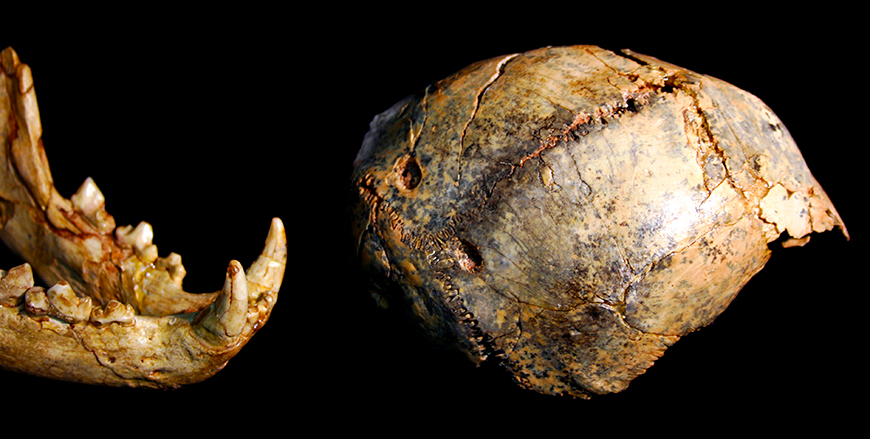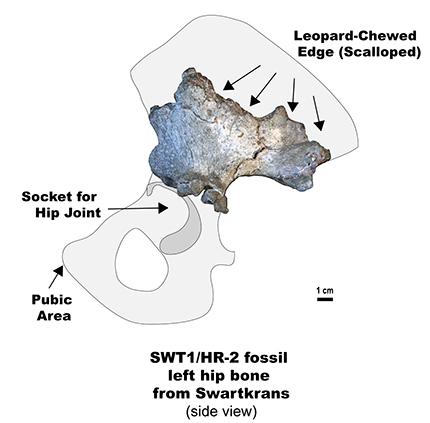A hipbone from Paranthropus robustus, a species of hominin thought to have lived alongside our direct ancestors, has revealed they also walked upright. Besides confirming their similarity to us, the discovery also reveals how small Paranthropus was and how vulnerable it would have been given the fearsome predators of its environment, and also complicates the story we have told about their sex lives.
ADVERTISEMENT
The species Paranthropus robustus was named in 1938, based on South African fossils. Although specimens have been found from six caves, all are tightly bunched in the Cradle of Humankind near Johannesburg. Moreover, their fossil record is dominated by skulls, teeth, and jaws – telling us a lot about their brain capacity, but obscuring their posture and lifestyle.
That’s why the hip, thigh, and shinbone found at Swartkrans Cave – the first place P. robustus and Homo fossils were found together – are so significant. They look like smaller versions of our own counterparts, and prove this was a species that walked upright, rather than having an ape-like posture suited to living in trees.
Like most topics in paleoanthropology, the status of Paranthropus has long been debated, with some arguing they belong in the Australopithecines, rather than deserving their own genus. Given the evidence that Lucy, the most famous Australopithecine, was something of a tree dweller, their upright status reinforces the independent status of P. robustus.
The fossil is from a small individual, just 103 centimeters (3.4 feet) high and weighing 27 kilograms (60 pounds). There’s always a danger with fossils of mistaking a child’s bone for an adult’s and getting sizes wrong, but the authors of a paper on the bone think this came from an adult, albeit a young one.
“It is estimated that this individual, probably a female, was only about a meter tall and 27 kg when it died,” Professor Travis Pickering of the University of Wisconsin-Madison said in a statement. That means it was; “Even smaller than adults from other diminutive early human species, including those represented by the famous ‘Lucy’ (Australopithecus afarensis, about 3.2 million years old) and ‘Hobbit’ (Homo floresiensis, about 90,000 years old) skeletons.” P. boisei, the other member of its genus, was considerably larger.
The area around Swartkrans Cave is known to have been inhabited by giant hyenas and sabertooth cats at the time, and the bones show marks that could have come from modern leopards. A creature this small would have been almost exactly a leopard’s preferred prey weight and ill-equipped to fight off such threats, even with stone tools.

Leopard lower jawbone next to a skull fragment of a juvenile Paranthropus robustus. Note the puncture marks that exactly match the tooth separation.
Image Credit: Jason L. Heaton
Yet somehow, P. robustus was a survivor. “Although it seems that this particular Paranthropus robustus individual was the unfortunate victim of predation, that conclusion does not mean that the entire species was inept,” Pickering said. “We know that Paranthropus robustus survived in South Africa for over a million years.” The hip and leg bones are from a layer between 2.3 and 1.7 million years old, the earlier part of P. robustus’ long presence.
P. robustus fossils are always found around stone tools, but there is still debate whether they were the makers or if credit goes to Homo ergaster, our direct ancestor that lived in the area at the same time. Walking upright doesn’t prove P. robutus were tool makers, but a major reason to stop traveling on all fours is to leave free hands for carrying.

The Paranthropus robustus hip bone showing where a leopard apparently chewed the edge, and a reconstruction of the missing parts.
Image Credit: Jason L. Heaton
The P. robustus skulls and teeth come in two distinct sizes. Although the sex of individual skulls can’t be determined with certainty, the favored explanation is that males were much larger than females. When this sort of sexual dimorphism is seen among animals – for example, gorillas – it’s usually associated with a dominant male mating with multiple females, while other males are excluded unless they can overthrow the king.
However, this fossil complicates matters, as the estimated weight falls neatly between the estimates. based on skulls. of 32 kilograms (70 pounds) for males and 24 kilograms (53 pounds) for females. Other features don’t help either, with some aspects of the bones’ shape usually associated with male hominins, while one is much more typically female in modern humans. However, some of these sex indicators have been shown not to apply among australopith fossils.
ADVERTISEMENT
The study is published in the Journal of Human Evolution
Source Link: Tiny Human Relatives Walked Upright 2 Million Years Ago, World-First Fossil Find Reveals